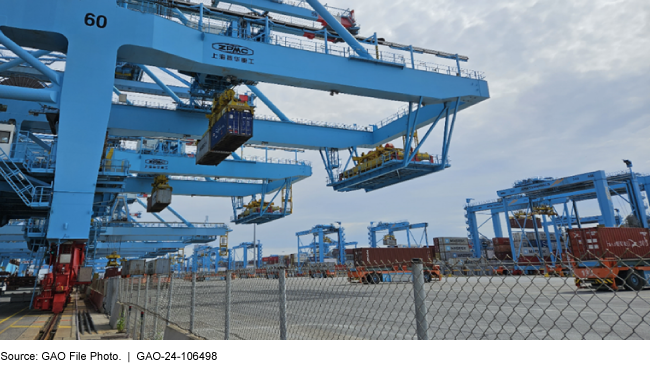Port Infrastructure: U.S. Ports Have Adopted Some Automation Technologies and Report Varied Effects
Fast Facts
All 10 of the largest U.S. container ports are using some form of automation technology to process and handle cargo. At least 1 terminal at each port uses it to track and communicate container movements.
Port operators consider factors like costs, profitability, priorities, and labor agreements when deciding whether to automate.
Some port stakeholders said automation can improve worker safety, simplify tasks, and increase efficiency. Others noted mixed effects on performance, such as one port's automated equipment working slower than conventional equipment. Other possible tradeoffs include, for example, reductions or changes in port jobs.
Semi-automated double trolley cranes load containers onto automated guided vehicles

Highlights
What GAO Found
Automation technology at ports reduces human involvement in processing and handling cargo. All of the 10 largest U.S. container ports have adopted automation technology to varying degrees. At least one terminal at each of these ports uses process automation technology to optimize, track, or communicate container movements (e.g., automated gate systems). Four also use automated cargo handling equipment to load, unload, and move containers. Selected foreign ports generally adopted more automation technologies than U.S. ports due to factors such as larger container volumes and variations in labor availability.
Automated Cargo Handling Equipment at TraPac Los Angeles Terminal

U.S. and international port stakeholders agreed that automation technologies can improve worker safety by separating humans from machines and can reduce emissions by improving efficiency. However, they reported mixed effects on the workforce, security, and performance. For example, a few terminal operators said automated equipment could stack containers more densely than conventional equipment, increasing capacity; others said this equipment moved containers more slowly than conventional equipment, reducing performance. Similarly, a few stakeholders said automation can reduce jobs; others said automation can create more comfortable work environments and new, higher-skilled positions.
Officials from U.S. ports and terminal operators said operators consider factors such as labor, costs, priorities, and operations when deciding whether to automate. The relative importance of these factors varies based on the unique circumstances of each port and terminal.
The Department of Transportation, the Environmental Protection Agency, and the Federal Maritime Commission conduct some activities that are related to port automation, though few of these activities are explicitly focused on port automation. For instance, GAO identified eight discretionary grant programs which do not explicitly support port automation, but which ports could use to acquire certain automation technologies.
Why GAO Did This Study
U.S. ports' ability to efficiently move containers into and out of terminals is crucial for the U.S. economy. In 2020, coastal ports handled cargo that accounted for nearly half of U.S. trade. Faced with increased container volumes and supply chain challenges, some ports in the U.S. and abroad have adopted automation technologies to improve performance and increase capacity.
The Ocean Shipping Reform Act of 2022 included a provision for GAO to describe the adoption of technologies at U.S. ports as compared to foreign ports. This report describes: (1) the adoption of automation technologies by selected U.S. container ports and similarities to technologies adopted by selected foreign container ports; (2) the reported effects of port automation technologies; (3) how U.S. terminal operators consider these effects and other factors when deciding whether to adopt automation technologies; and (4) federal activities related to the development or adoption of port automation technologies.
GAO analyzed information from equipment manufacturers, ports, and terminal operators. These ports included the 10 largest U.S. container ports by volume and 10 foreign ports selected for factors such as volume and location. GAO visited U.S. and foreign ports and interviewed port and terminal operator officials at these ports, as well as nine other industry stakeholders, including two labor unions. GAO also reviewed federal documents and interviewed officials from six federal entities.
For more information, contact Andrew Von Ah at (202) 512-2834 or VonAha@gao.gov.
